Minimalist kitchens are becoming a popular choice for homeowners looking to create a serene cooking environment. These spaces elegantly combine function and simplicity, allowing for a clean aesthetic that promotes peace and productivity.
Each design is unique, featuring clever storage solutions, beautiful materials, and thoughtful layouts that are perfect for enjoying your culinary adventures.
Who else loves the feeling of a clutter-free kitchen? Minimalist kitchen design isn’t about being boring — it’s about creating a space that feels calm, clean, and effortlessly stylish.
Let’s explore how simple design choices can turn your kitchen into your favorite room!
Minimalist Kitchen Design Ideas
1. Neutral Tones: The Essence of Calm
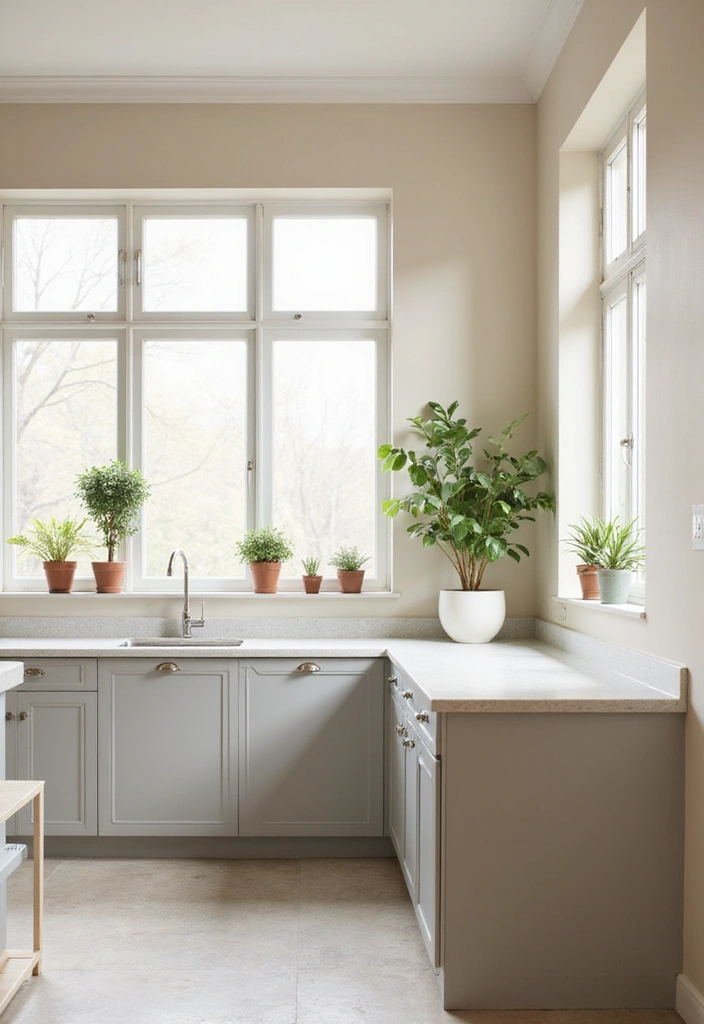
Neutral tones are the backbone of minimalist designs, creating a soothing atmosphere in your kitchen. Shades like white, beige, and soft gray can make your space feel more expansive and inviting.
Incorporating these colors gives a sense of tranquility while allowing the beauty of your design elements to shine through. Consider a white kitchen with light wood accents for warmth or a gray palette paired with black fixtures for a modern touch.
– Choose a single color scheme: Stick with shades of one color for a cohesive look.
– Layer textures: Mix materials like wood, stone, and metal to add depth.
– Use natural light: Large windows can enhance the calming effect of neutral tones.
To keep your space feeling fresh, add small pops of color through kitchen accessories or plants. A few well-placed green plants or vibrant dishware can create a beautiful contrast against the neutral backdrop.
2. Smart Storage Solutions
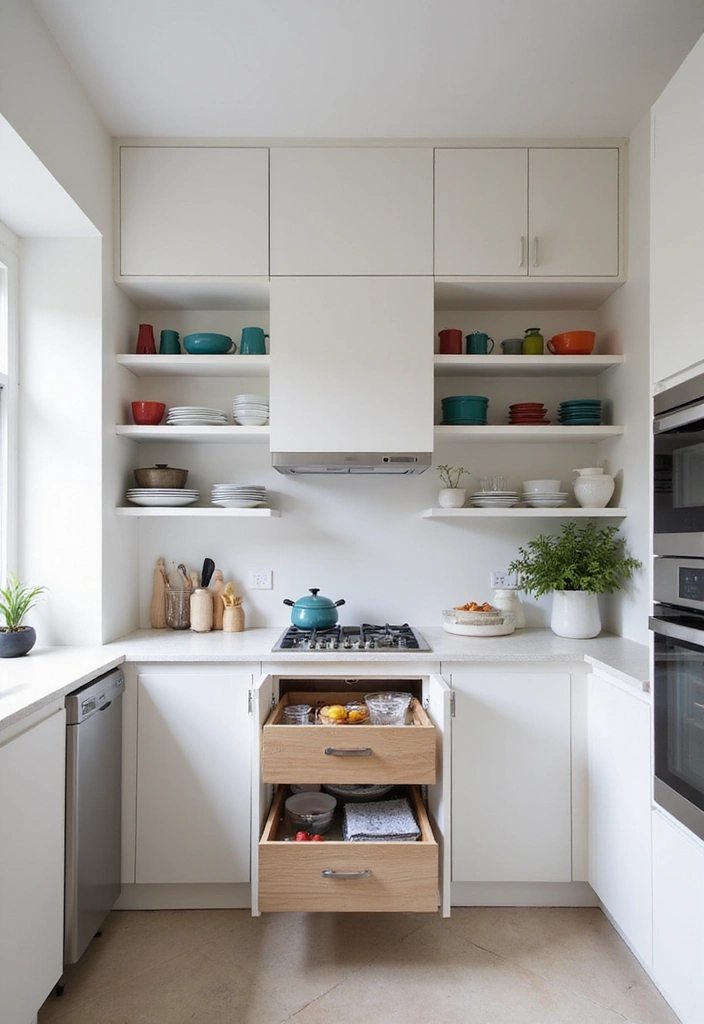
Maximizing space is crucial in any kitchen, and minimalist designs excel in smart storage solutions. By cleverly utilizing vertical space and hidden compartments, you can keep countertops clutter-free and maintain the clean lines that define minimalism.
Consider built-in cabinets that extend to the ceiling or under-cabinet shelves to showcase beautiful dishware.
– Use drawer dividers: Keep utensils organized and easily accessible.
– Install open shelving: Display your favorite dishes while keeping them within reach.
– Incorporate pull-out cabinets: Maximize corner spaces with pull-out shelves.
These design ideas not only save space but also enhance the aesthetic of your kitchen. A well-organized kitchen encourages cooking and creates an atmosphere of calm and order, inviting you to spend more time creating delicious meals.
3. Emphasis on Functionality
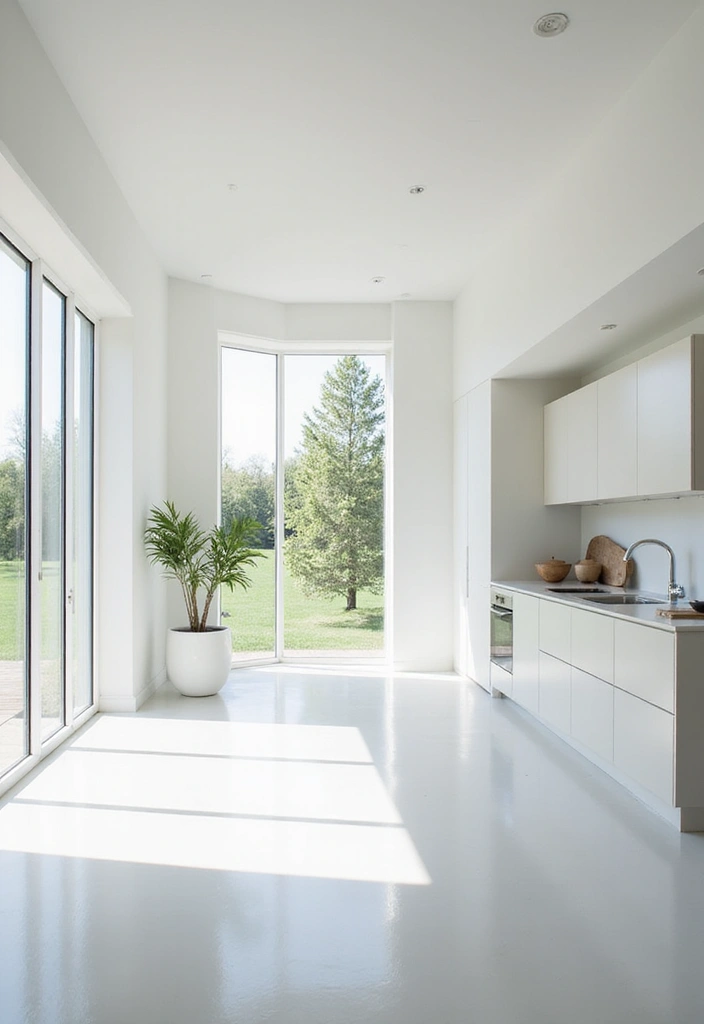
In minimalist kitchens, functionality is paramount. Every element should serve a purpose, enhancing your cooking experience while maintaining a clean aesthetic. This approach encourages you to choose appliances and tools that are not only beautiful but also effective. For instance, a sleek induction cooktop saves space and provides precise cooking control, while a wall-mounted pot rack frees up cabinet space.
– Invest in multi-functional appliances: Look for gadgets that perform multiple tasks.
– Choose easy-to-clean surfaces: Smooth finishes minimize maintenance.
– Opt for simple lines: Avoid ornate designs that complicate the overall look.
By prioritizing functionality, you create a kitchen that works for you, allowing you to enjoy cooking without distractions. A thoughtfully designed minimalist kitchen enables a seamless workflow, making meal preparation a breeze.
4. Natural Materials
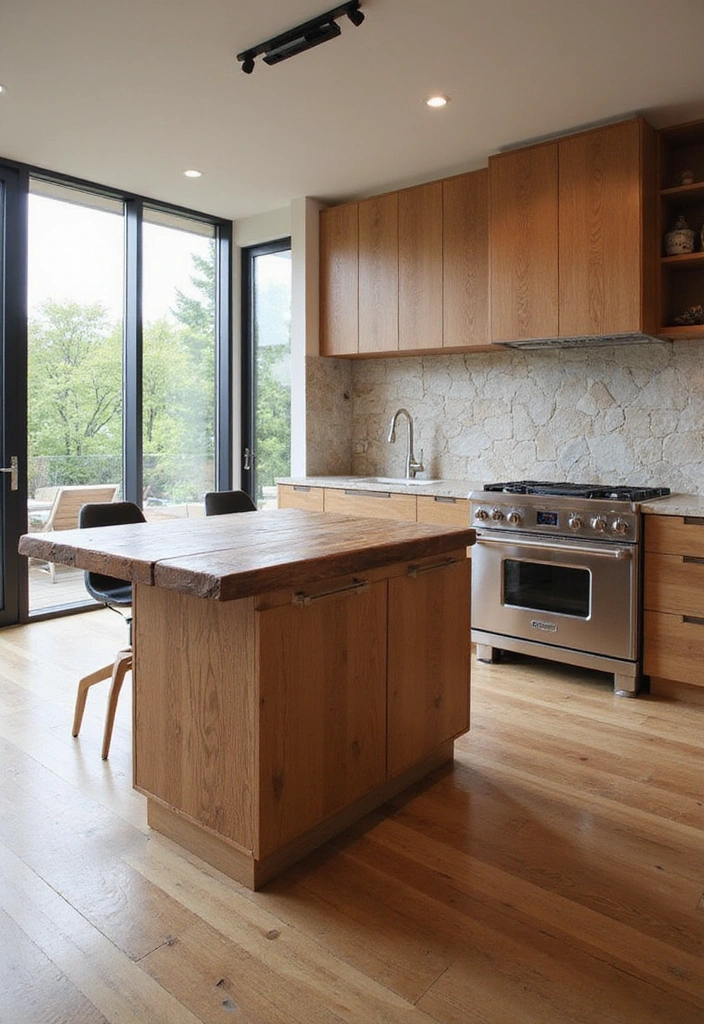
Using natural materials in your minimalist kitchen adds warmth and character while maintaining simplicity. Wood, stone, and metal can be beautifully combined to create a harmonious environment. For example, a wooden island paired with stainless steel appliances can strike the perfect balance between warmth and modernity. Consider using reclaimed wood for cabinetry or countertops to bring an eco-friendly touch.
– Mix materials: Pair different textures for added interest.
– Choose sustainable options: Bamboo or reclaimed wood are great choices.
– Incorporate stone features: A natural stone backsplash can be a stunning focal point.
Natural materials not only contribute to the aesthetics but also promote a sense of connection to the outdoors. This approach encourages a calming cooking atmosphere, enhancing your culinary experience by creating a space that feels inviting and organic.
5. Streamlined Appliances
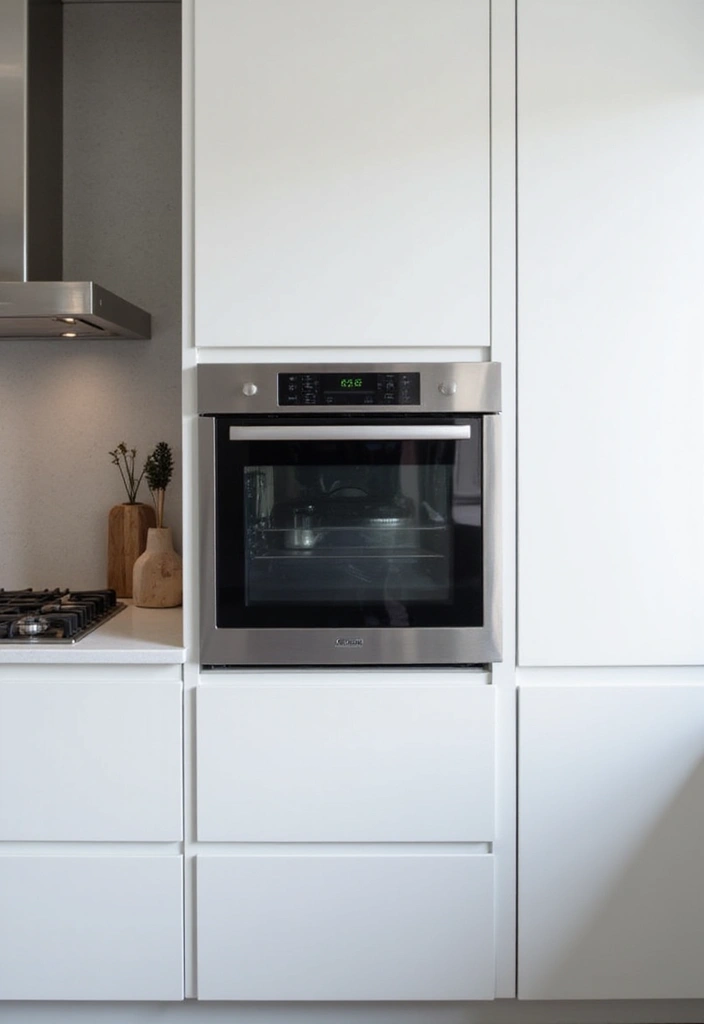
In a minimalist kitchen, choosing streamlined appliances is essential to maintain a clean look. Opt for built-in appliances that blend seamlessly with cabinetry or choose appliances with simple, sleek designs. This not only saves space but also enhances the overall aesthetic of your kitchen, allowing your decor to shine rather than competing with bulky machines.
– Select integrated designs: Built-in refrigerators and dishwashers can create a cohesive look.
– Choose simple finishes: Stainless steel or matte black finishes are modern and stylish.
– Avoid excess features: Look for appliances that prioritize essential functions.
By keeping appliances streamlined, you ensure that your kitchen remains uncluttered and visually appealing. This focus on simplicity allows for easier maintenance and creates a peaceful cooking environment, making every meal preparation a pleasure.
6. Open Concept Spaces
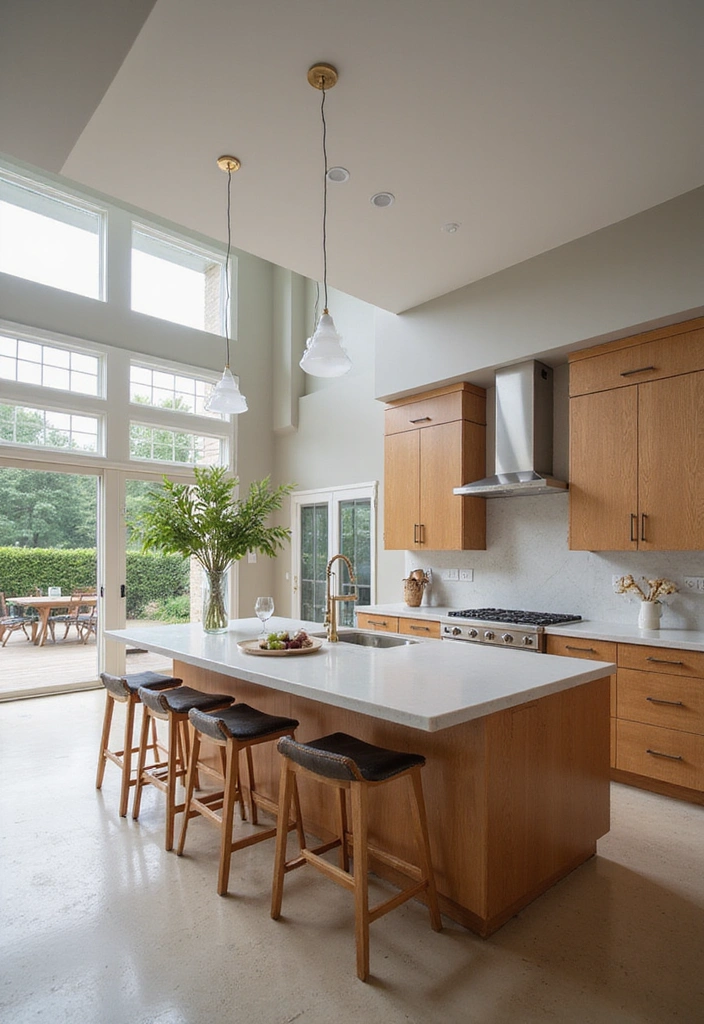
Open concept kitchens are a hallmark of modern minimalist design, allowing for fluid transitions between cooking, dining, and living areas. This design approach promotes social interaction while cooking and creates an airy, spacious feel. Removing walls to connect your kitchen with the living area can significantly enhance the overall flow of your home.
– Use a large island: An island can serve as a divider while providing additional prep space.
– Choose cohesive color schemes: Maintain a consistent palette throughout connected spaces.
– Incorporate multifunctional furniture: Use dining tables that can double as prep areas.
An open concept kitchen encourages family gatherings and socializing, enhancing your cooking experience. By breaking down barriers, you create a welcoming atmosphere that invites collaboration and creativity in the kitchen, making it the heart of the home.
7. Minimalistic Lighting
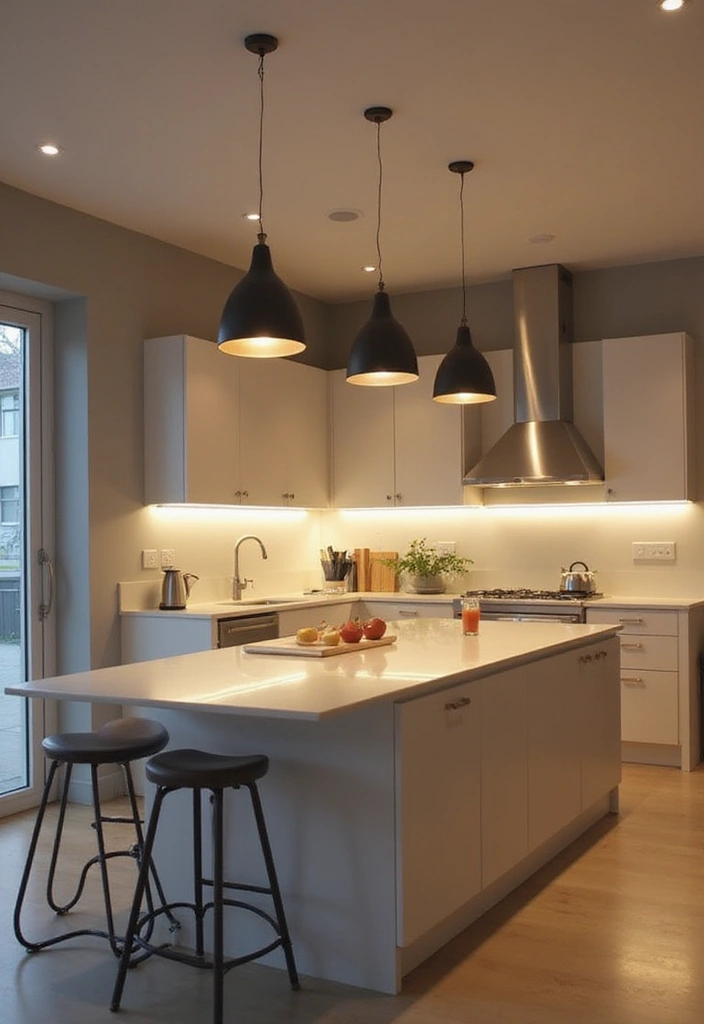
Lighting plays a crucial role in minimalist kitchens, enhancing the clean lines and simplicity of the design. Opt for pendant lights or recessed lighting that complements your kitchen’s aesthetic without overwhelming it. Lighting should be functional yet stylish, providing ample illumination while maintaining the minimalist vibe.
– Choose statement fixtures: A single, bold pendant light can serve as a focal point.
– Incorporate under-cabinet lighting: This adds warmth and highlights countertops.
– Use dimmer switches: Control the ambiance for different cooking or dining experiences.
By using minimalistic lighting, you can create an inviting atmosphere that enhances your cooking space. Thoughtful lighting choices can transform your kitchen from a utilitarian space to a warm, welcoming environment, perfect for both cooking and entertaining.
8. Incorporating Greenery
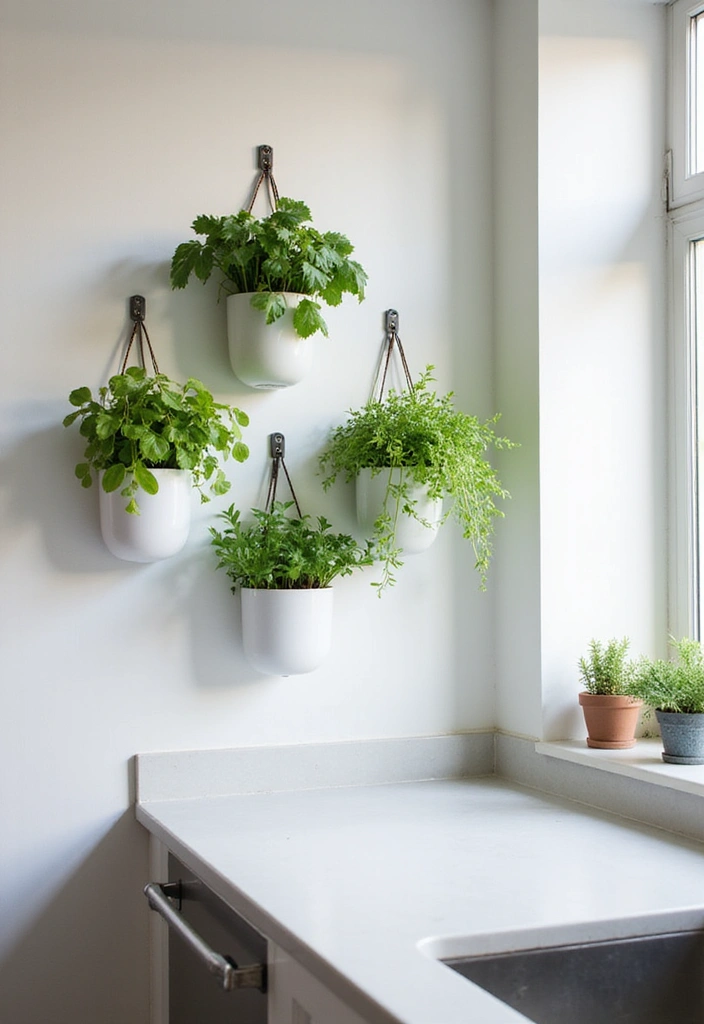
Bringing plants into your minimalist kitchen can add life and color while maintaining simplicity. Houseplants or herb gardens not only improve air quality but also enhance the aesthetic appeal of your cooking space.
Use wall-mounted planters or small pots on windowsills to incorporate greenery without cluttering the countertops.
– Use herbs for cooking: Basil, rosemary, and mint can thrive indoors and be used in your meals.
– Choose low-maintenance plants: Succulents or snake plants are great options.
– Incorporate vertical gardens: Maximize space by growing plants vertically on walls.
By adding greenery to your kitchen, you create a serene atmosphere that encourages creativity. The natural beauty of plants can complement your minimalist design, making your cooking space feel fresh and inviting.
9. Focus on Simplicity
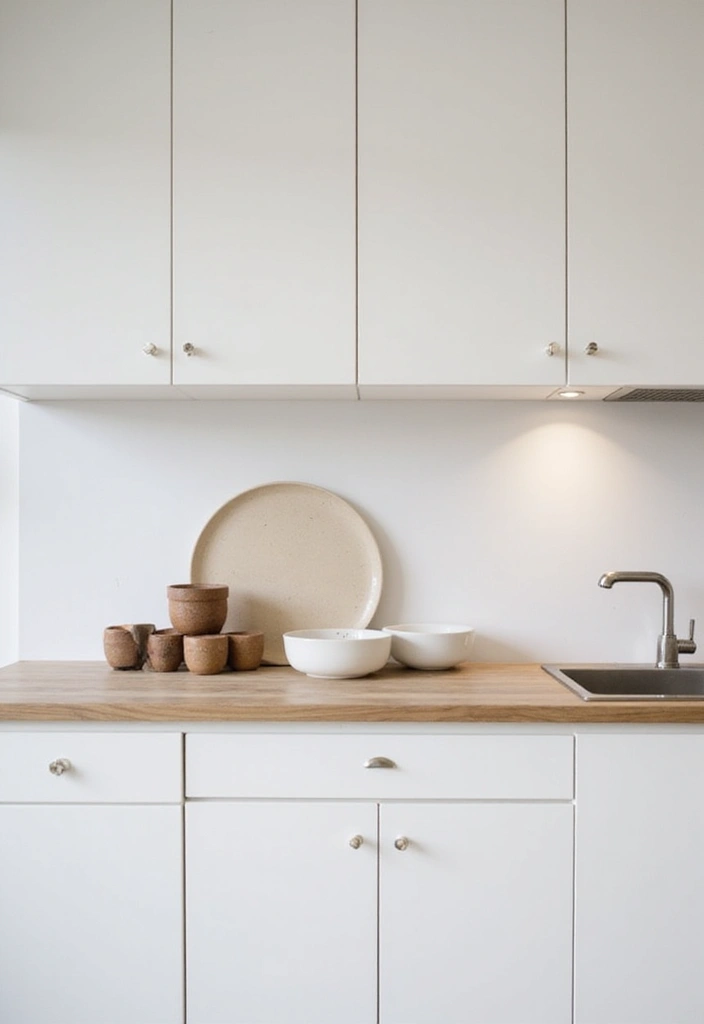
Simplicity is the essence of minimalist kitchen design. Every element should have a purpose, and unnecessary decorations should be avoided. A few well-chosen items can make a big impact without overwhelming the space. Consider using simple dishware, plain cabinetry, and minimalist decor to maintain a clean look.
– Limit decorative items: Choose a few statement pieces rather than cluttering surfaces.
– Opt for simple dishware: White or neutral plates can enhance the minimalist vibe.
– Keep countertops clear: Store small appliances and tools in cabinets or drawers.
By focusing on simplicity, you create a calm and organized kitchen that is easy to navigate. A clean, uncluttered space invites creativity and makes cooking enjoyable, allowing you to focus on the joy of preparing meals.
10. Monochromatic Designs
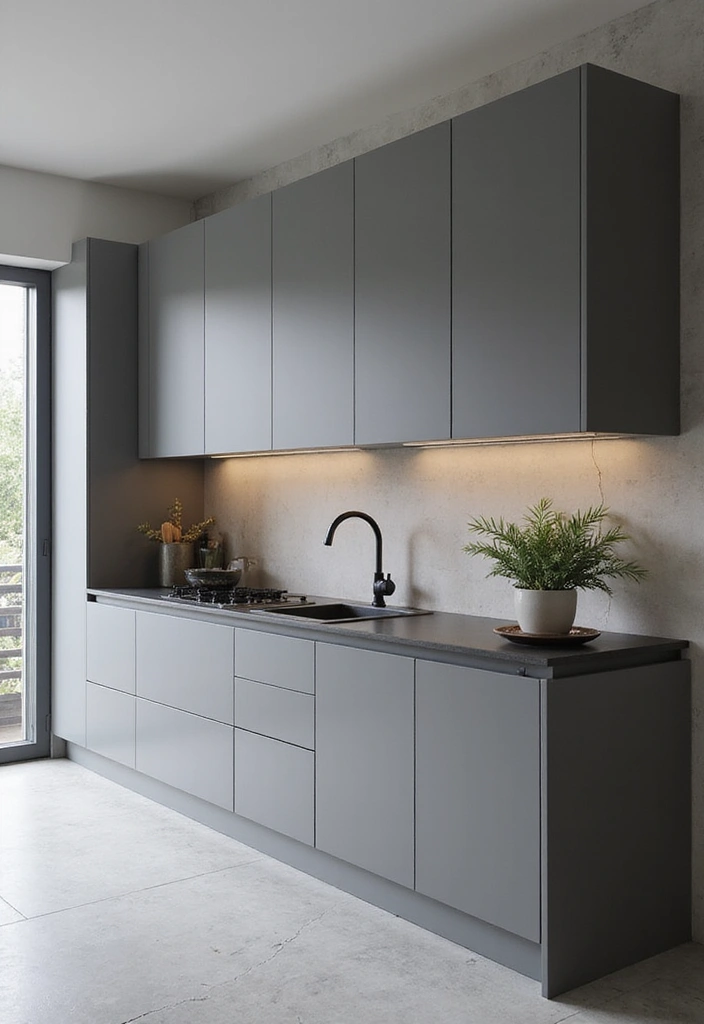
Monochromatic designs offer a visually striking approach to minimalist kitchens. By using varying shades of a single color, you create depth while maintaining a cohesive look.
This technique can make your kitchen feel more expansive and organized.
– Choose a dominant color: White, gray, or black can create a sleek environment.
– Incorporate different textures: Use matte and glossy finishes for visual interest.
– Add subtle accents: Consider adding a few contrasting elements for balance.
Monochromatic kitchens can be incredibly stylish and modern, showcasing the beauty of simplicity. This design choice invites creativity and allows for easy integration of personal touches through accessories and decor.
11. Vintage Minimalism
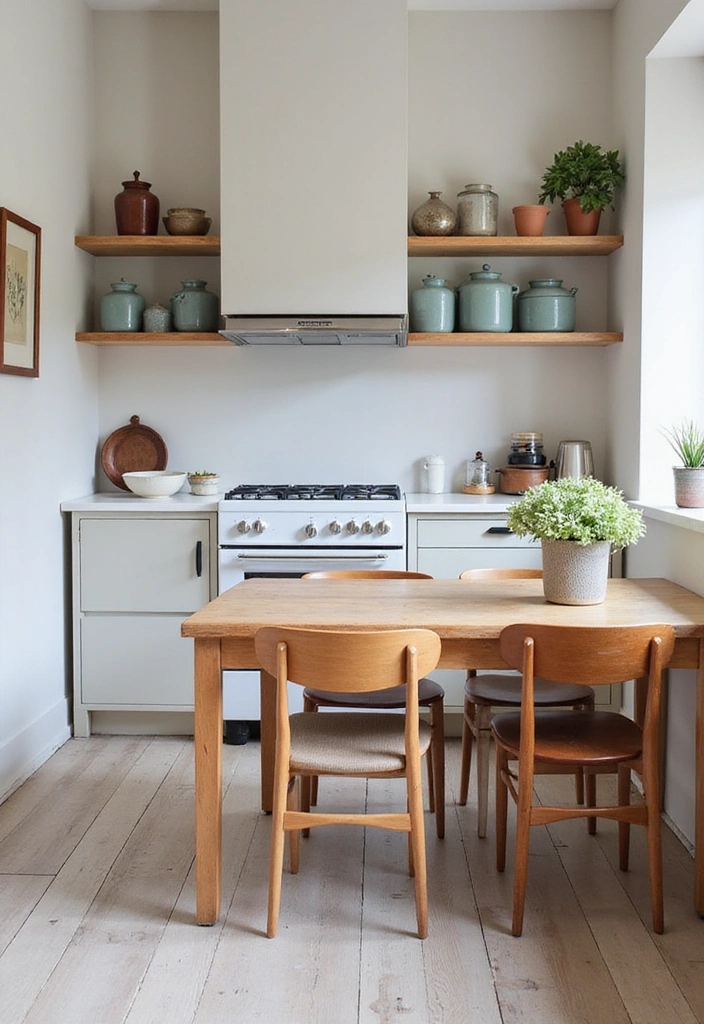
Combining vintage elements with minimalist design can create a unique and inviting kitchen. Look for antique or vintage pieces that serve a purpose, such as old-fashioned canisters or a vintage dining table. These items add character while still adhering to a minimalist philosophy.
– Incorporate heirloom pieces: Use family heirlooms that have a story.
– Choose vintage-style appliances: Retro designs can offer modern functionality with nostalgic charm.
– Mix old and new: Pair vintage items with modern fixtures for contrast.
This blend of styles creates a warm kitchen atmosphere that feels personal and authentic. Vintage minimalism allows you to showcase your personality while maintaining a clean and uncluttered space, inviting creativity and comfort.
12. Integrated Technology
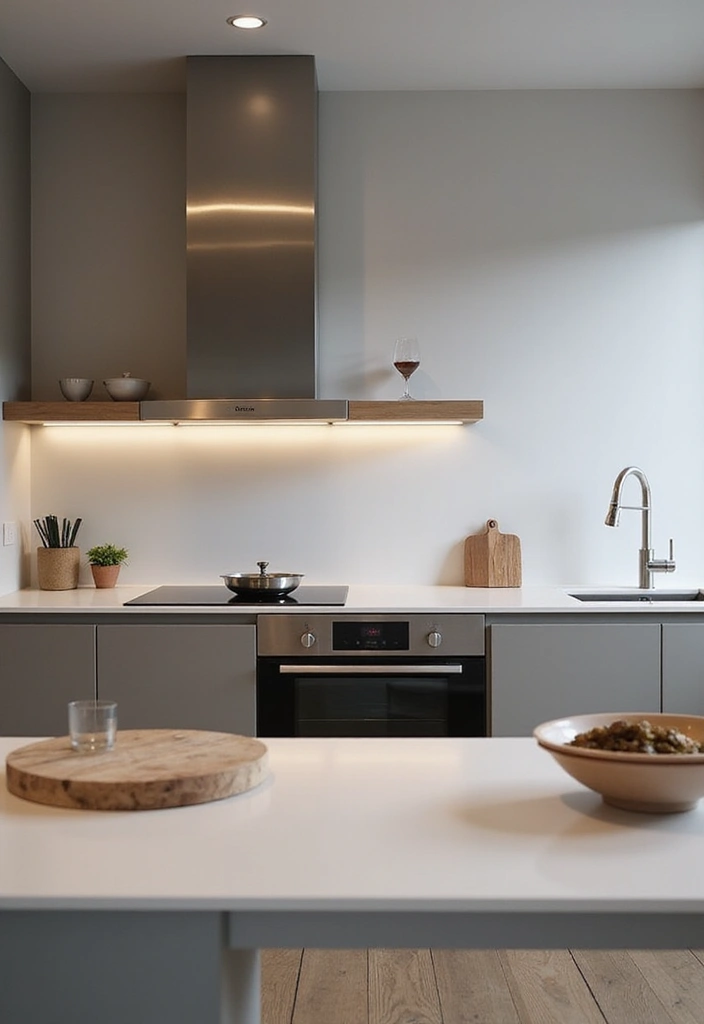
Integrating technology into your minimalist kitchen can enhance both function and style. Smart appliances can streamline your cooking process, while built-in features keep your kitchen looking clean and modern. Consider touchless faucets or smart ovens that can be controlled via your phone for added convenience.
– Opt for smart appliances: Look for devices that integrate with home automation.
– Hide cords and cables: Use cable management solutions to keep surfaces tidy.
– Integrate lighting controls: Smart lighting can adjust to your needs and preferences.
By blending technology with minimalist design, you create a kitchen that is not only stylish but also highly functional. This modern approach enhances your cooking experience, making it easier and more enjoyable to prepare meals.
13. Minimalist Color Blocking
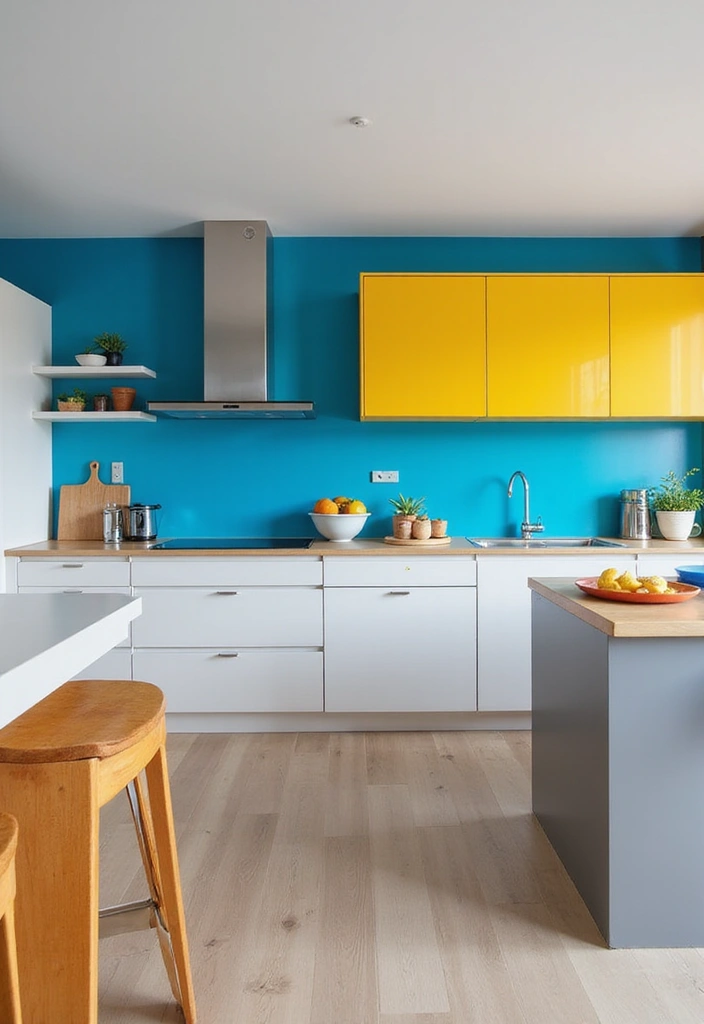
Color blocking can add a playful touch to your minimalist kitchen without overwhelming the space. By using bold colors in strategic areas, you can create visual interest while maintaining a streamlined look. Consider painting one wall a bright color or using colorful backsplashes to bring energy into the room.
– Limit the color palette: Choose two or three colors for a cohesive look.
– Use color to define areas: Different colors can delineate the cooking and dining spaces.
– Incorporate accessories: Use colorful dishware or kitchen tools to tie in the color scheme.
Color blocking can energize your kitchen while keeping it feeling modern and organized. This design choice allows for personal expression and creativity while adhering to minimalist principles.
14. Seamless Backsplashes
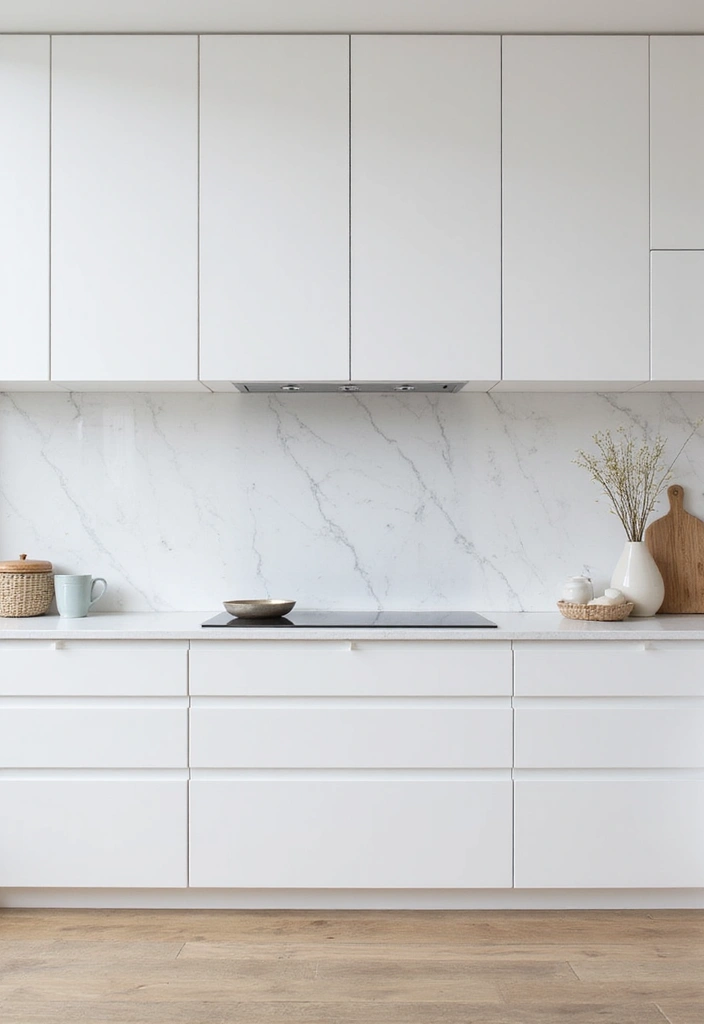
A seamless backsplash can enhance the minimalist aesthetic of your kitchen by creating a smooth transition between surfaces.
Whether you choose a solid color or a subtle texture, a seamless design can unify the look of your kitchen while keeping it clean and sophisticated. Consider using materials like glass or large-format tiles for a sleek finish.
– Choose matching materials: Use the same material as your countertops for a cohesive look.
– Consider textured finishes: Textured backsplashes can add depth without being overwhelming.
– Keep it simple: Avoid busy patterns to maintain minimalism.
A seamless backsplash can make your kitchen feel larger and more open, enhancing the overall design. This subtle detail can elevate your minimalist kitchen, contributing to a polished and elegant atmosphere.
15. Minimalist Dining Nooks
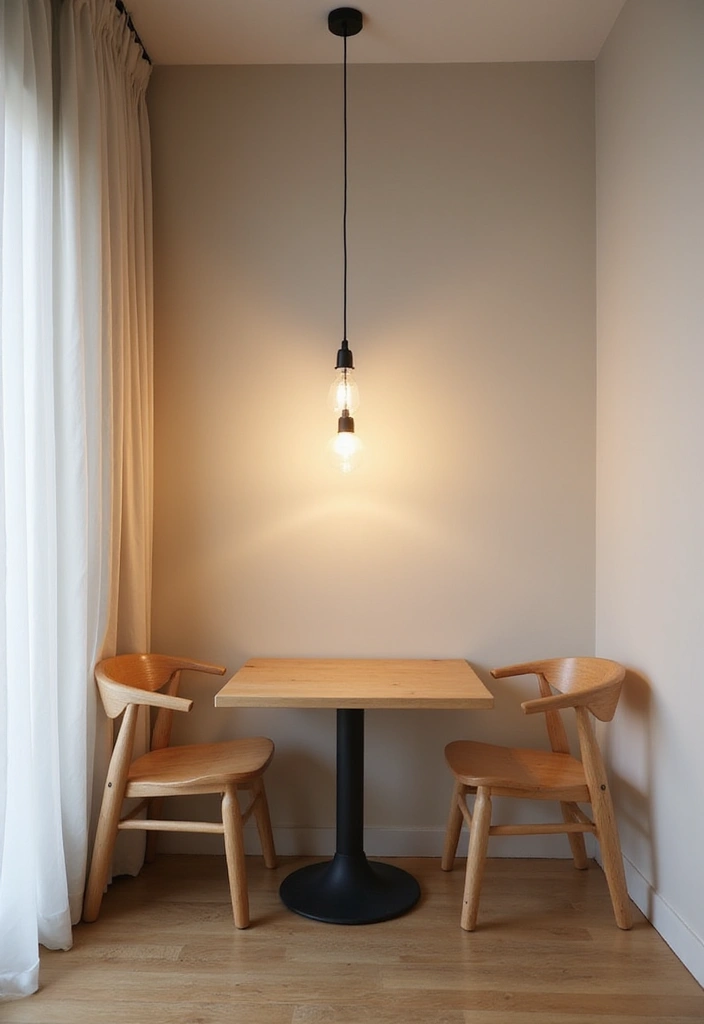
Creating a minimalist dining nook within your kitchen can enhance functionality while maintaining a stylish look. A small table with simple chairs can provide a cozy space for meals without cluttering your kitchen. Consider using built-in seating for a streamlined appearance.
– Choose space-saving furniture: Look for collapsible or stackable chairs for flexibility.
– Incorporate lighting: Add pendant lights or wall sconces to define the dining area.
– Use natural materials: Wood or metal can keep the look cohesive and modern.
A minimalist dining nook can make your kitchen feel more complete and welcoming, providing a space for family meals and gatherings. This functional design invites conversation and connection, making your kitchen the heart of your home.
16. Functional Wall Art

Incorporating functional wall art into your minimalist kitchen can enhance the design while serving a purpose.
Use pegboards for organizing kitchen tools or hanging artwork that doubles as a chalkboard for notes and recipes. This approach allows you to maintain a clean and organized space while adding personality.
– Choose art with function: Look for pieces that can hold utensils or spices.
– Incorporate personal touches: Display your favorite recipes or family photos.
– Use a cohesive color scheme: Ensure that the artwork complements your kitchen’s palette.
Functional wall art can add a unique touch to your minimalist kitchen, encouraging creativity and organization. This design choice keeps surfaces clutter-free while allowing you to express your style and make the space your own.
17. Open Shelving Trends
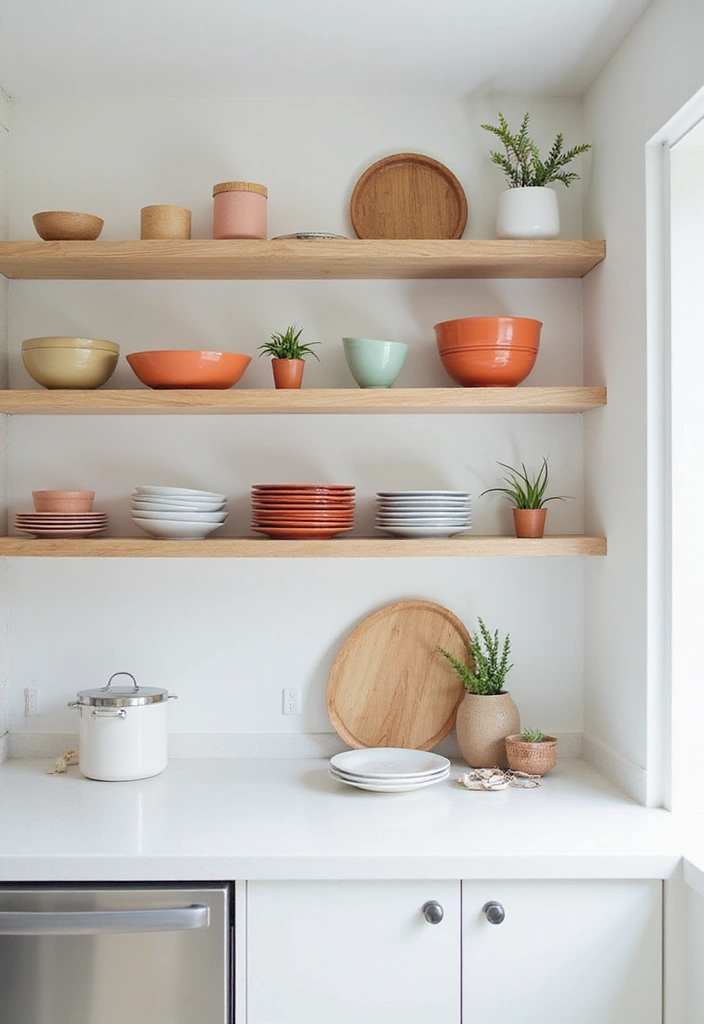
Open shelving is a popular trend in minimalist kitchens, providing a place to showcase beautiful dishware while keeping the design airy and open.
This approach encourages organization and creativity, allowing you to display your favorite items without cluttering surfaces. Consider using simple brackets for a clean look.
– Limit clutter: Only display items you use regularly.
– Use cohesive dishware: Choose a color palette that complements your kitchen.
– Incorporate decorative elements: Add plants or art pieces to enhance the design.
Open shelving can create a welcoming atmosphere in your kitchen, making it feel more like a living space. This design choice promotes creativity and encourages you to curate your kitchen items, showcasing your unique style.
18. Minimalist Textiles
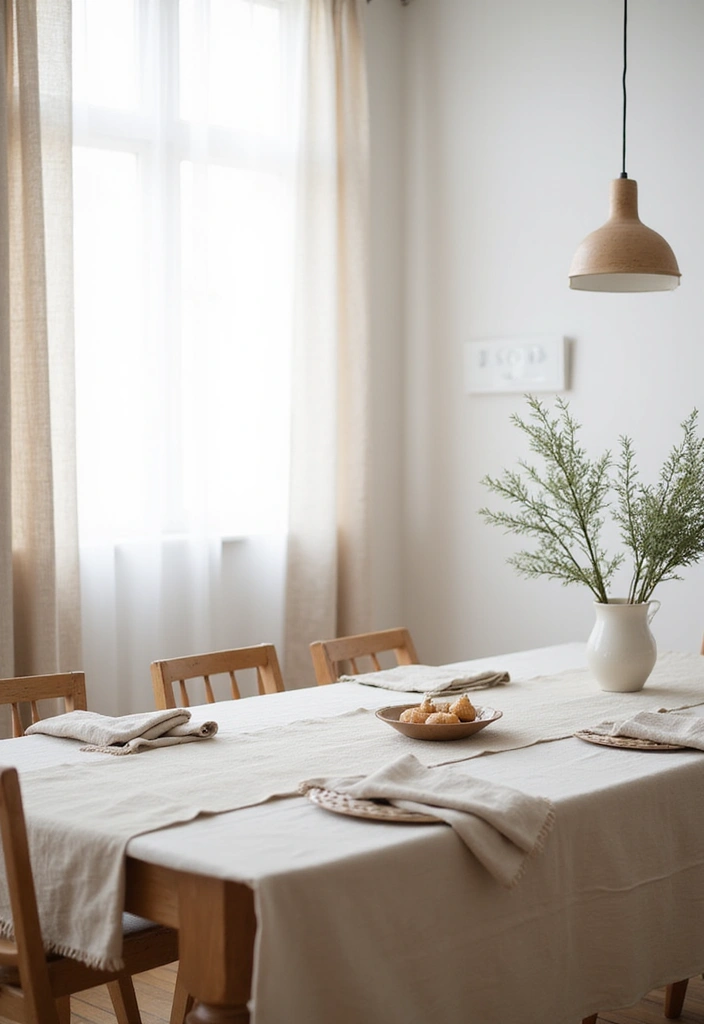
Incorporating minimalist textiles into your kitchen can soften the space while maintaining a clean look.
Choose simple table linens, dish towels, and curtains in neutral or muted colors to enhance the overall design. This approach adds warmth and comfort without overwhelming the minimalist aesthetic.
– Opt for natural materials: Cotton or linen are great choices that feel inviting.
– Choose simple patterns: Stripes or solid colors can enhance the design without being busy.
– Limit accessories: Keep textiles to a minimum to maintain cleanliness.
Minimalist textiles can elevate your kitchen’s design, creating a cozy atmosphere that invites cooking and gathering. This thoughtful approach ensures that every element contributes to the overall simplicity and beauty of the space.
19. Clean Lines and Shapes
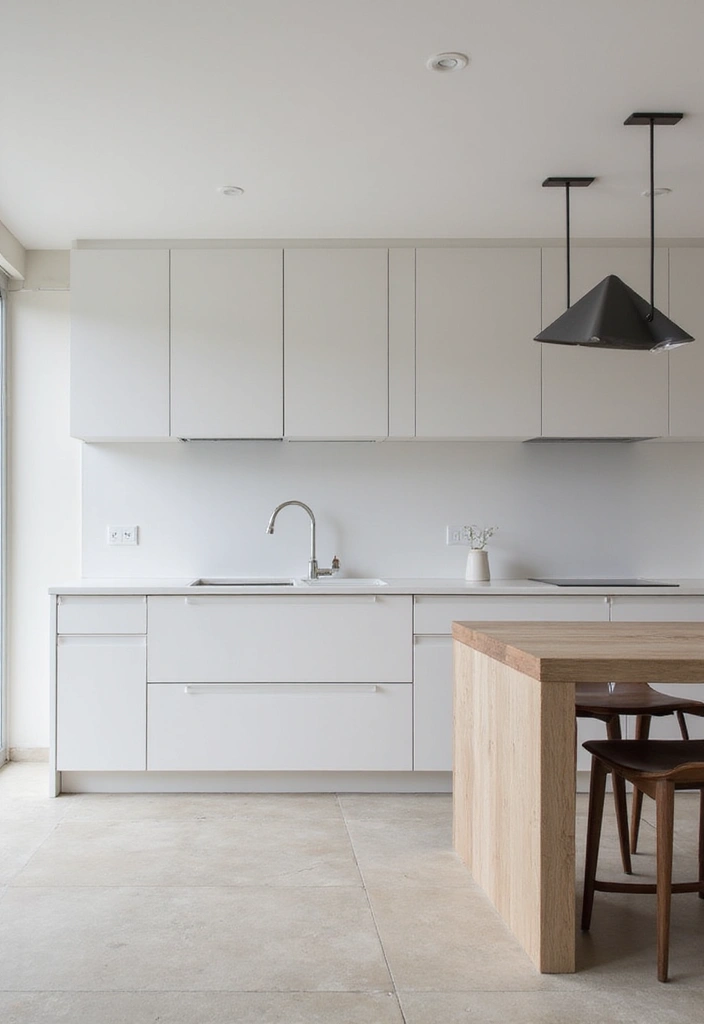
In minimalist kitchens, clean lines and geometric shapes are essential to achieving a sleek aesthetic. Opt for cabinetry, countertops, and appliances with sharp, defined edges to create a modern look.
This design choice enhances the overall simplicity of your kitchen, allowing for easy navigation and a calm atmosphere.
– Choose flat-panel cabinets: These offer a clean and streamlined appearance.
– Incorporate geometric accents: Use simple shapes in decor to enhance the design.
– Keep surfaces smooth: Avoid ornate details that can complicate the look.
By focusing on clean lines and shapes, you create a kitchen that feels organized and sophisticated. This approach promotes a sense of order, making your cooking space more enjoyable and inviting.
20. Bright and Airy Spaces

Creating a bright and airy kitchen is essential in minimalist design, as it enhances the feeling of space and openness.
Use light colors and ample natural light to make your kitchen feel larger and more inviting. Consider large windows and a light color palette to achieve this effect.
– Choose reflective surfaces: Glossy finishes can help bounce light around.
– Incorporate large windows: Allow natural light to flood the space.
– Use light colors: Whites, pastels, or soft neutrals can create a bright atmosphere.
A bright and airy kitchen promotes a positive cooking experience, encouraging creativity and enjoyment. This design choice emphasizes the beauty of simplicity, creating a space that feels welcoming and uplifting.
21. Thoughtful Accessory Choices

Choosing the right accessories can enhance your minimalist kitchen without cluttering the space.
Focus on quality over quantity, selecting a few statement pieces that reflect your style and serve a purpose. From elegant dishware to stylish storage solutions, thoughtful choices can elevate your kitchen’s design.
– Limit decorative items: Choose only a few key pieces for display.
– Incorporate functional accessories: Look for items that serve both beauty and function.
– Use a cohesive color scheme: Ensure that accessories complement your kitchen’s palette.
By making thoughtful accessory choices, you create a kitchen that feels personal and connected to your style. This approach enhances the overall minimalism while allowing you to express your personality through carefully curated items.
FAQ
What makes a kitchen “minimalist” in design?
A minimalist kitchen focuses on clean lines, neutral colors, and clutter-free countertops. It’s about choosing functional, high-quality essentials and creating open space.
How do I start creating a minimalist kitchen?
Begin by decluttering and investing in sleek, practical storage. Stick to a neutral color palette, opt for simple hardware, and let light and space do the talking.
Can minimalist kitchen design still feel cozy?
Absolutely! Minimalism isn’t about feeling cold — add warmth with natural textures like wood, soft lighting, and a few carefully chosen decor pieces.
